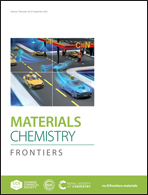Universal synthesis of rare earth-doped FeP nanorod arrays for the hydrogen evolution reaction†
Abstract
A universal plasma-assisted strategy is proposed for the fabrication of rare earth (RE)-doped FeP nanorod arrays (RE-FeP) as a kind of potential electrocatalyst for the hydrogen evolution reaction (HER). The energetic Ar plasma can induce the vacancy-enriched feature of the Fe-precursor, which assists in the anchoring of RE ions. As a typical model, Sm-FeP affords a low overpotential of 71 mV at 10 mA cm−2 for the HER, which is 63 mV smaller than that of FeP and superior to most reported Fe-based catalysts. The robust long-term stability of Sm-FeP is also demonstrated. Furthermore, the as-assembled Sm-FeP‖RuO2 water-splitting electrolyzer also displays a low cell voltage of 1.59 V at 10 mA cm−2. Sm-induced electronic configuration modulation at the Fe site mainly contributes to the improved HER performance of Sm-FeP relative to FeP. The combination between the Sm site and *OH produces labile O 2p states below the Fermi level, thus weakening the co-adsorption of *OH and *H derived from the splitting of H2O for the facilitated formation of *H. Moreover, the other RE-FeP catalysts (e.g., Yb, Eu, La, and Er) extended by such a plasma-induced strategy also exhibit various improved degrees in the HER, implying that RE-FeP is a promising class of electrocatalyst towards the HER.

- This article is part of the themed collections: Materials Chemistry Frontiers Emerging Investigator Series 2022–2023 and Materials Chemistry Frontiers Most Popular Articles 2023


 Please wait while we load your content...
Please wait while we load your content...